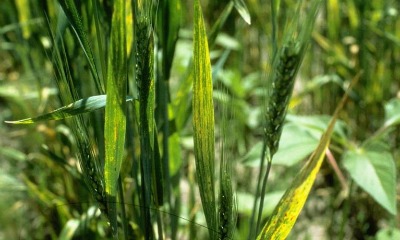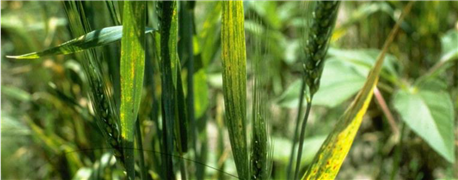February 1, 2016

Wheat streak mosaic virus cost Kansas wheat growers yield losses of more than 4.25 million bushels in 2013, an economic impact of $32.6 million.
Realizing that threat, the Kansas Wheat Alliance has provided the funding that will allow researchers to find the wheat genes that will provide additional resistance to the deadly virus.
Dr. Guorong Zhang, Kansas State University wheat breeder, is leading this research with his team at the K-State Agricultural Research Center in Hays.

COSTLY VIRUS: Wheat streak mosiac is a costly virus that robs growers of significant yields. Research funded by Kansas wheat growers will help researchers find new sources of geneetic resistance.
K-State agronomist Jeanne Falk-Jones compares the wheat streak mosaic virus to the flu virus in humans. "It is the toughest on the young because they have a harder time fighting off the virus," she said. "In addition, there is no medicine or treatment to cure the virus. Wheat that is stressed will be more susceptible to severe symptoms. This includes stress from drought, lack of nutrients, or poor growing conditions. "
Three current genes are known to have wheat streak mosaic virus resistance, referred to by number: Wsm1,Wsm2 and Wsm3. Of these three genes, only one is found in conventional wheat - Wsm2. The other two genes come from a wild wheat relative, Thinopyrum intermedium.
This Wsm2 gene is important because wheat breeders start by using genes from wheat before exploring the complicated introductions of genes from other wheat relatives.
Four existing wheat varieties include the Wsm2 gene: RonL, Snowmass, Oakley CL and Clara CL. But, as Zhang pointed out, all these resistant varieties have the same resistance source.
As a result, if the virus evolves under selection pressure and breaks down this resistance, then all the currently-resistant varieties would become susceptible. Therefore, it is necessary to explore new resistant sources and discover new resistance genes, which researchers can then introduce into new varieties or stack with Wsm2 to make the resistance more durable.
To find new resistance genes for K-State wheat varieties, Zhang and his team are testing 20 new resistant plant introductions (13 from winter-type wheats and seven from spring-type wheats). These have been selected from more than 3,000 germplasm lines, to try and identify if any of these varieties has a gene for wheat streak mosaic resistance other than Wsm2.
Among the 13 winter-type wheat lines, Zhang and his team have found two lines that may contain a gene different from Wsm2. They have initiated the process to introduce these two resistance sources into their elite breeding lines, which should introduce another barrier for the wheat streak mosaic virus.
Zhang is continuing the search for other unique genes with virus resistance in the seven spring-type resistant sources. His initial testing shows great promise for one line that might have a different resistance gene than Wsm2. Early indications are that the resistance gene in this line should be located in a different genomic region than Wsm2, which would provide a more durable resistance to wheat streak mosaic virus when stacked with Wsm2. Zhang's team is continuing to work on this line to identify its location within the wheat genome and its linked molecular markers.
While the search continues, Zhang's team is zeroing in on this new resistance gene. In the near future, this new gene will be introduced into elite breeding lines and be stacked with Wsm2 or other resistance genes.
As a result of this Kansas Wheat Alliance-funded research, Kansas farmers will have more protection of wheat crop yield potential thanks to more durable resistance to wheat streak mosaic virus.
Source: Kansas Wheat
You May Also Like




